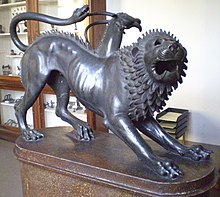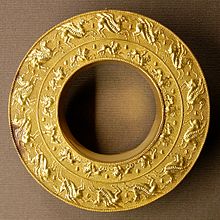|
Greek city of Sikyon in Sikyonia
Silver Hemidrachm 15mm (2.50
grams)
Struck 360-330 B.C.
Reference: Sear 2774
Chimera standing left; ΣΙ beneath.
Dove flying left.
In the 5th and 4th Centuries this important mint produced two large issues of
silver staters and associated fractional denominations. The first was probably
by the principal war-coinage of the Peloponnesian allies during the long
struggle with Athens.
You are bidding on the exact
item pictured, provided with a Certificate of Authenticity and Lifetime
Guarantee of Authenticity.
The Chimera was, according to
Greek mythology
, a monstrous fire-breathing
female and male creature of
Lycia
in
Asia Minor
, composed of the parts of three
animals — a lion
, a
snake
and a
goat. Usually depicted as a lion, with the head of a goat arising
from its back, and a tail that ended in a snake’s head, the Chimera was one of
the offspring of Typhon
and
Echidna
and a sibling of such monsters as
Cerberus
and the
Lernaean Hydra
.

The term chimera has come to describe any mythical or fictional animal with
parts taken from various animals, or to describe anything perceived as wildly
imaginative or implausible.
Description

“Chimera
of Arezzo“: an
Etruscan
bronze
Homer’s brief description in the
Iliad
is the earliest surviving literary
reference: “a thing of immortal make, not human, lion-fronted and snake behind,
a goat in the middle, and snorting out the breath of the terrible flame of
bright fire”. Elsewhere in the Iliad, Homer attributes the rearing of
Chimera to Amisodorus.
Hesiod’s
Theogony
follows the Homeric description:
he makes the Chimera the issue of
Echidna
: “She was the mother of Chimaera who
breathed raging fire, a creature fearful, great, swift-footed and strong, who
had three heads, one of a grim-eyed
lion; in her hinderpart, a
dragon
; and in her middle, a
goat, breathing forth a fearful blast of blazing fire. Her did
Pegasus and noble Bellerophon slay” The author of the
Bibliotheca
concurs: descriptions agree
that she breathed fire
. The Chimera is generally considered to
have been female (see the quotation from Hesiod above) despite the
mane
adorning its
lion‘s head, the inclusion of a close mane often was depicted on
lionesses, but the ears always were visible (that does not occur with depictions
of male lions). Sighting the Chimera was an omen of
storms
,
shipwrecks
, and
natural disasters
(particularly
volcanoes
).

Gold reel, possibly an ear-stud, with
winged Pegasus
(outer band) and the
Chimera (inner band),
Magna Graecia
or
Etruria
, fourth century BC (Louvre)
While there are different
genealogies
, in one version the Chimera mated
with her brother Orthrus
and mothered the
Sphinx
and the
Nemean lion
(others have Orthrus and their
mother, Echidna, mating; most attribute all to Typhon and Echidna).
The Chimera finally was defeated by
Bellerophon
, with the help of
Pegasus
, at the command of
King Iobates
of
Lycia
. Since Pegasus could fly, Bellerophon
shot the Chimera from the air, safe from her heads and breath. A
scholiast
to Homer adds that he finished her
off by equipping his spear with a lump of lead that melted when exposed to the
Chimera’s fiery breath and consequently killed her, an image drawn from
metalworking.
Robert Graves
suggests,[10]
“The Chimera was, apparently, a calendar-symbol of the tripartite year, of which
the seasonal emblems were lion, goat, and serpent.”

Pebble mosaic depicting Bellerophon killing the Chimera, from
Rhodes
archaeological museum
The Chimera was situated in foreign Lycia, but her representation in the arts
was wholly Greek. An autonomous tradition, one that did not rely on the written
word, was represented in the visual repertory of the Greek vase-painters. The
Chimera first appears at an early stage in the
proto-Corinthian
pottery-painters’ repertory,
providing some of the earliest identifiable mythological scenes that can be
recognized in
Greek art
. The Corinthian type is fixed, after
some early hesitation, in the 670s BC; the variations in the pictorial
representations suggest to Marilyn Low Schmitt a multiple origin. The
fascination with the monstrous devolved by the end of the seventh century into a
decorative Chimera-motif in Corinth, while the motif of Bellerophon on Pegasus
took on a separate existence alone. A separate Attic tradition, where the goats
breathe fire and the animal’s rear is serpent-like, begins with such confidence
that Marilyn Low Schmitt is convinced there must be unrecognized earlier local
prototypes. Two vase-painters employed the motif so consistently they are given
the pseudonyms the Bellerophon Painter and the Chimaera Painter. A
fire-breathing lioness was one of the earliest of solar and war deities in
Ancient Egypt (representations from 3000 years prior to the Greek) and
influences are feasible.
In
Etruscan civilization
, the Chimera appears in
the “Orientalizing” period that precedes Etruscan Archaic art; that is to say,
very early indeed. The Chimera appears in Etruscan wall-paintings of the fourth
century BC.
In Medieval art
, though the Chimera of Antiquity
was forgotten, chimerical figures appear as embodiments of the deceptive, even
Satanic
forces of raw nature. Provided with a
human face and a scaly tail, as in
Dante’s
vision of
Geryon
in
Inferno
xvii.7–17, 25–27, hybrid monsters,
more akin to the
Manticore
of
Pliny’s Natural History
(viii.90), provided
iconic representations of hypocrisy and fraud well into the seventeenth century,
through an emblemmatic representation in
Cesare Ripa’s
Iconologia.
Classical sources
The myths of the Chimera can be found in
BibliothecaPseudo-Apollodorus’
(book 1),
Homer’s
Iliad
(book 6);
Hyginus
‘ Fabulae 57 and 151;
Ovid’s
Metamorphoses
(book VI 339; IX 648); and
Hesiod’s
Theogony
319ff.
Virgil
, in the
Aeneid
(book 5) employs Chimaera for
the name of Gyas’
gigantic ship in the ship-race, with
possible allegorical significance in contemporary Roman politics.
Hypothesis about
origin

The eternal fires of
Chimera
in
Lycia
, modern-day Turkey, where the
myth takes place
Main article:
Mount Chimaera
Pliny the Elder
cited
Ctesias
and quoted
Photius
identifying the Chimera with an area of
permanent gas vents which still can be found today by hikers on the
Lycian Way
in southwest
Turkey
. Called in Turkish
Yanartaş
(flaming rock), it consists of
some two dozen vents in the ground, grouped in two patches on the hillside above
the Temple of
Hephaestus
about 3 km north of
Çıralı
, near ancient
Olympos
, in
Lycia
. The vents emit burning
methane
thought to be of
metamorphic
origin, which in ancient times were
landmarks
by which sailors could navigate.

Neo-Hittite Chimera from
Karkemish
, at the
Museum of Anatolian Civilizations
The Neo-Hittite Chimera from
Carchemish
, dated to 850–750 BC, which is now
housed in the
Museum of Anatolian Civilizations
no doubt
served as a basis for the Greek legend. It differs from the Greek version in
that while there are three heads, none of them is that of a goat, only a main
human head, a lion’s head facing forward and placed on the chest of the lion’s
body, and a snake’s head placed at the end of the tail.
Use
for Chinese mythological creatures
Some western scholars of Chinese art, starting with
Victor Segalen
, use the word “chimera”
generically to refer to winged quadrupeds, such as
bixie
,
tianlu
, and even
qilin
.
Sikyon (Greek:
Σικυών) was an
ancient Greek
city situated in the northern
Peloponnesus
between
Corinth
and
Achaea
on the territory of the present-day prefecture of
Corinthia
. The king-list given by
Pausanias
comprises twenty-four kings, beginning with the
autochthonous
Aegialeus; the penultimate king of the list,
Agamemnon
, compels the submission of Sicyon to
Mycenae
;
after him comes the
Dorian
usurper
Phalces
. Pausanias shares his source with
Castor of Rhodes
, who used the king-list in compiling tables of
history; the common source was convincingly identified by F. Jacoby
as a lost Sicyonica by the late fourth-century poet
Menaechmus
of Sicyon.
Sicyon was built on a low triangular
plateau
about two miles from the
Corinthian Gulf
. Between the city and its port lay a fertile plain
with olive
groves and orchards. After the
Dorian invasion
the community was divided into the ordinary three
Dorian tribes and an equally privileged tribe of
Ionians
, besides which a class of
serfs
lived on and worked the land.
For some centuries, Sicyon remained subject to
Argos
,
whence its Dorian conquerors had come; as late as
500 BC
it acknowledged a certain suzerainty. However, its virtual
independence was established in the
7th century BC
, when a line of tyrants arose and initiated an
anti-Dorian policy. Chief of these rulers was the founder’s grandson
Cleisthenes
, the uncle of the Athenian legislator
Cleisthenes
. Besides reforming the city’s constitution to the
advantage of the Ionians and replacing Dorian cults with the worship of
Dionysus
, Cleisthenes gained renown as the chief instigator and
general of the
First Sacred War
(590
BC) in the interests of the
Delphians
.
About this time, Sicyon developed the various industries for which it
was noted in antiquity. As the abode of the sculptors
Dipoenus and Scyllis
it gained pre-eminence in woodcarving and
bronze work such as is still to be seen in the archaic metal facings
found at
Olympia
. Its pottery, which resembled
Corinthian ware
, was exported with the latter as far as
Etruria
.
In Sicyon also the art of
painting
was supposed to have been invented. After the fall of the
tyrants their institutions survived till the end of the 6th century BC,
when Dorian supremacy was re-established, perhaps by the agency of
Sparta
under the ephor
Chilon
, and the city was enrolled in the
Peloponnesian League
. Henceforth, its policy was usually determined
either by Sparta
or
Corinth
.
In the
5th century BC
Sicyon, like Corinth, suffered from the commercial
rivalry of Athens
in the western seas, and was repeatedly harassed by squadrons
of Athenian ships. In the
Peloponnesian War
Sicyon followed the lead of Sparta and Corinth.
When these two powers quarreled after the
peace of Nicias
it remained loyal to the Spartans. Again in the
Corinthian war
, Sicyon sided with Sparta and became its base of
operations against the allied troops round Corinth. In
369
it
was captured and garrisoned by the
Thebans
in their successful attack on the Peloponnesian League.
During this period Sicyon reached its zenith as a centre of art: its
school of painting gained fame under
Eupompus
and attracted the great masters
Pamphilus
and
Apelles
as students; its sculpture was raised to a level hardly surpassed in
Greece by
Lysippus
and his pupils.
The destruction of Corinth (146)
brought Sicyon an acquisition of territory and the presidency over the
Isthmian games
; yet in
Cicero
‘s
time it had fallen deep into debt. Under the
Roman empire
it was quite obscured by the restored cities of Corinth
and
Patrae
; in
Pausanias
‘ age (A.D. 150) it was almost desolate. In
Byzantine
times it became a bishop’s seat, and to judge by its later
name Hellas it served as a refuge for the Greeks from the
Slavonic
immigrants of the 8th century.
The village of
Vasiliko
(described by the 1911
Encyclopedia Britannica
as “insignificant”) now occupies the
site.
This is one of the historical sites least visited by tourists in
Greece. As of 2006,
entry to all areas except the small museum is unrestricted.
|














